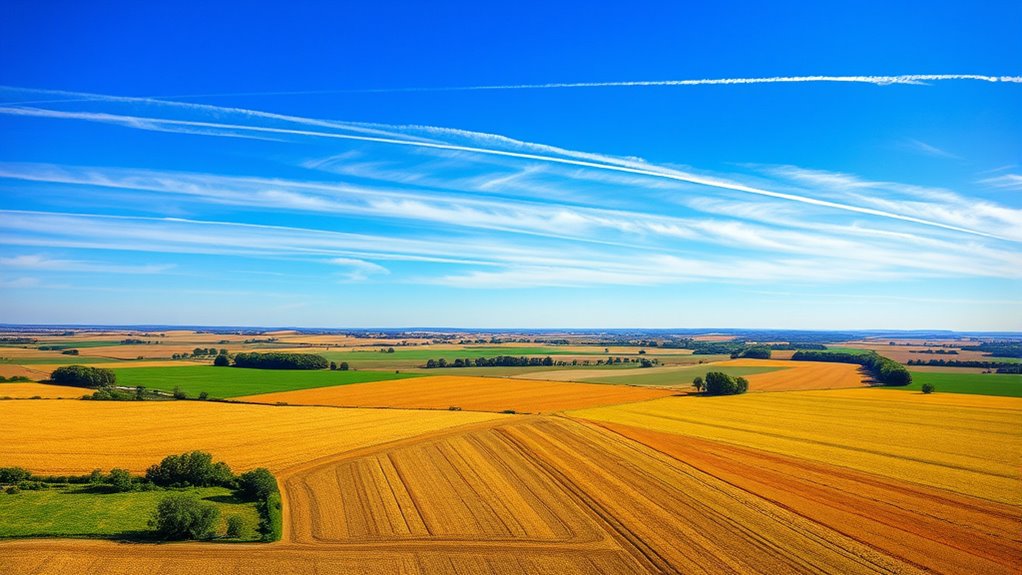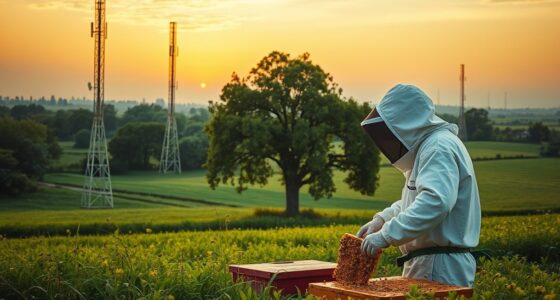Many sky trails over fields are mistaken for secret chemtrails, but they are usually contrails formed when aircraft release water vapor in cold, humid air. Factors like weather, temperature, and humidity determine how long these trails last and how they spread. Common misconceptions often come from misinterpreting natural phenomena or agricultural spraying. If you stay curious, you’ll discover how weather patterns and scientific explanations help you see past these myths more clearly.
Key Takeaways
- Contrails over fields are caused by aircraft water vapor, not secret chemical spraying, and their appearance depends on weather conditions.
- Persistent trails often result from atmospheric humidity and temperature, not covert programs or harmful aerosols.
- Agricultural spraying can produce sky trails, which are mistaken for chemtrails, but are part of normal farming practices.
- Scientific evidence shows no proof of large-scale aerosol spraying; most claims are based on misconceptions and misinformation.
- Differentiating contrails from chemtrails involves observing trail duration, spread, and consulting reputable atmospheric data.
Common Misconceptions About Chemtrails Over Rural Areas
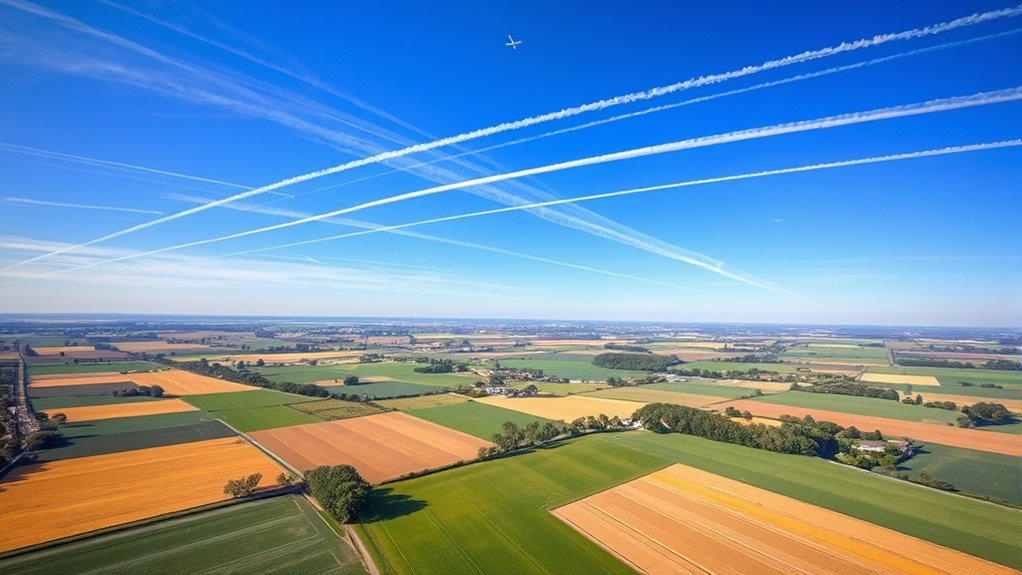
Many people believe that chemtrails are more visible or prevalent in rural areas, but this is a misconception. In reality, what you see over rural skies often resembles regular aircraft contrails caused by agricultural spraying or commercial flights. The idea that these trails are part of secret government programs stems from government secrecy surrounding certain activities, but most chemtrail claims lack evidence. Agricultural spraying, which is common in farming regions, can produce trails in the sky, fueling misconceptions. These activities are usually well-documented and regulated, unlike the secretive nature attributed to chemtrails. The visibility of trails in rural areas is often due to the open landscape, making them more noticeable, but that doesn’t mean they’re part of covert government operations. Additionally, the visibility of contrails can be heightened by weather conditions, making them appear more prominent in rural settings. The aircraft technology involved in spraying is similar to commercial aircraft, further complicating the myth. Moreover, the atmospheric conditions such as humidity and temperature play a significant role in how contrails appear and dissipate, which can enhance misconceptions about their origin. In some cases, the weather patterns can cause contrails to linger longer and spread out, mimicking the appearance of unusual trails.
Scientific Explanation of Contrails Versus Chemtrails
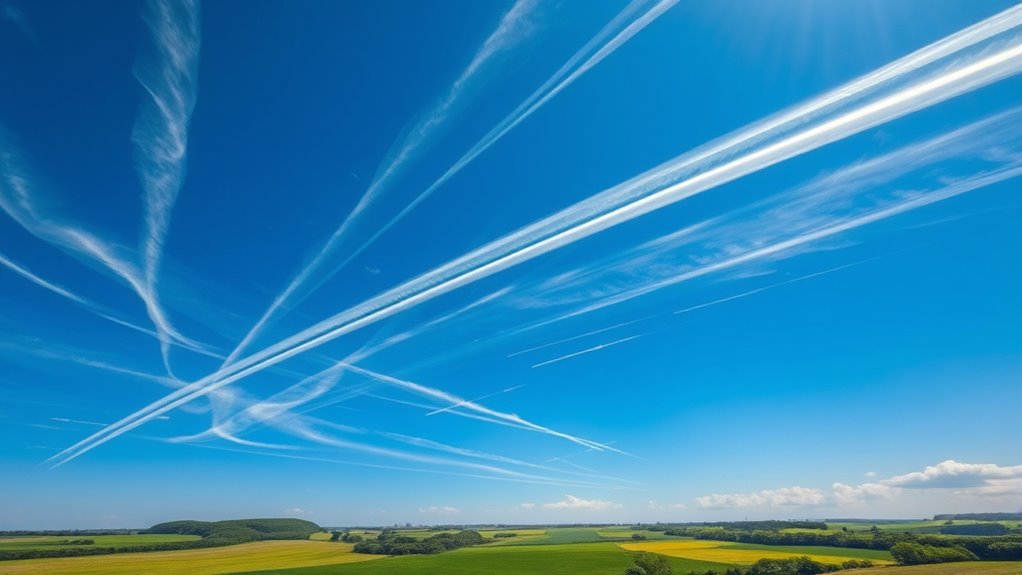
Contrails form when aircraft engines release water vapor into cold, upper-atmosphere air, creating visible ice-crystal trails that can persist and spread depending on atmospheric conditions. These trails are composed mainly of water ice crystals, with aerosol particles acting as nuclei for condensation. The aerosol composition in contrails is natural and derived from the aircraft’s fuel combustion process. The contrail lifespan varies based on humidity, temperature, and wind, often lasting from minutes to hours before dissipating. Additionally, the presence of particulate matter in contrails is a natural result of combustion, not a deliberate chemical spray. Chemtrails, a myth, suggest intentional spraying of chemicals, but scientifically, contrails are simply water vapor and aerosols forming ice crystals. Understanding the aerosol composition and contrail lifespan helps distinguish natural phenomena from baseless conspiracy theories.
The Role of Weather and Atmospheric Conditions in Trail Formation
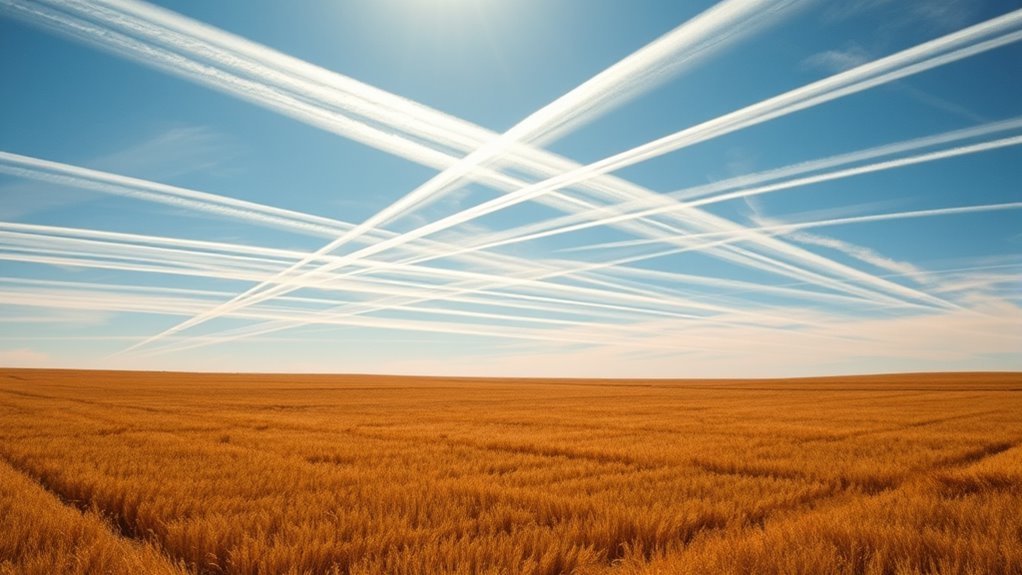
Weather and atmospheric conditions play a key role in how trails form and persist in the sky. Cloud cover, temperature, and humidity levels directly influence whether contrails stay visible or quickly dissipate. Understanding these factors helps clarify why trail appearance varies so much from day to day. Additionally, the presence of atmospheric conditions can influence the chemical composition and dispersal of trail particles, affecting their visibility and longevity. Variations in air pressure also impact how long trails remain in the sky before dispersing. Recognizing how weather patterns interact with these factors can further explain fluctuations in trail visibility and behavior. Moreover, specific humidity levels can either facilitate the formation of persistent contrails or cause them to disappear rapidly. Changes in temperature also significantly affect contrail development and persistence, especially when the air is near saturation.
Cloud Cover Influence
Cloud cover and atmospheric conditions play a crucial role in whether and how contrails form and persist in the sky. Your altitude effects determine if the air is cold enough for condensation, making contrails visible. Cloud interactions can either obscure or enhance these trails, depending on cloud type and density. Factors like humidity levels, wind patterns, and existing cloud cover influence trail longevity. When the sky is clear, contrails tend to dissipate quickly; with partial cloud cover, they may linger or spread. Thick clouds can mask contrails altogether, making them less noticeable. Overall, weather conditions and cloud interactions are key to understanding why some trails fade fast while others persist, debunking myths that chemtrails are anything beyond normal atmospheric phenomena. Additionally, understanding the specific cloud types involved helps clarify how weather impacts trail visibility and duration. Atmospheric conditions such as temperature, humidity, and wind patterns further determine contrail behavior, emphasizing that these phenomena are naturally occurring rather than deliberate interventions. Moreover, humidity levels directly affect the likelihood of contrail formation and their persistence over time. Recognizing the influence of cloud cover can help demystify many misconceptions about contrails and their origins.
Temperature and Humidity
Temperature and humidity levels directly influence whether condensation trails form and how long they last in the atmosphere. When temperature fluctuations occur, they can cause the air to cool rapidly, promoting condensation of water vapor into visible trails. Humidity variations also play a key role; higher humidity increases the likelihood of persistent contrails, while lower humidity causes them to evaporate quickly. If the air is moist, contrails can linger for hours, creating the illusion of extended trails. Conversely, dry conditions lead to rapid dissipation. These weather factors explain why contrail visibility varies so much from day to day. Understanding the effects of temperature fluctuations and humidity variations helps clarify that trail formation is a natural response to atmospheric conditions, not a sign of secret chemtrail activities. Herbal teas can also influence overall well-being, and many people find that drinking herbal tea helps them feel more relaxed and comfortable, especially during weather changes that affect atmospheric conditions. Variations in atmospheric conditions are also important for understanding natural weather phenomena, which are often mistaken for man-made activities. Recognizing these natural processes can help dispel misconceptions about chemtrails and promote a better understanding of atmospheric science. Additionally, scientific research supports the idea that weather plays a crucial role in the formation and persistence of contrails, further emphasizing their natural origin. Moreover, advancements in weather modeling have improved our ability to predict contrail formation based on atmospheric data.
Why Most Chemtrail Theories Lack Credible Evidence
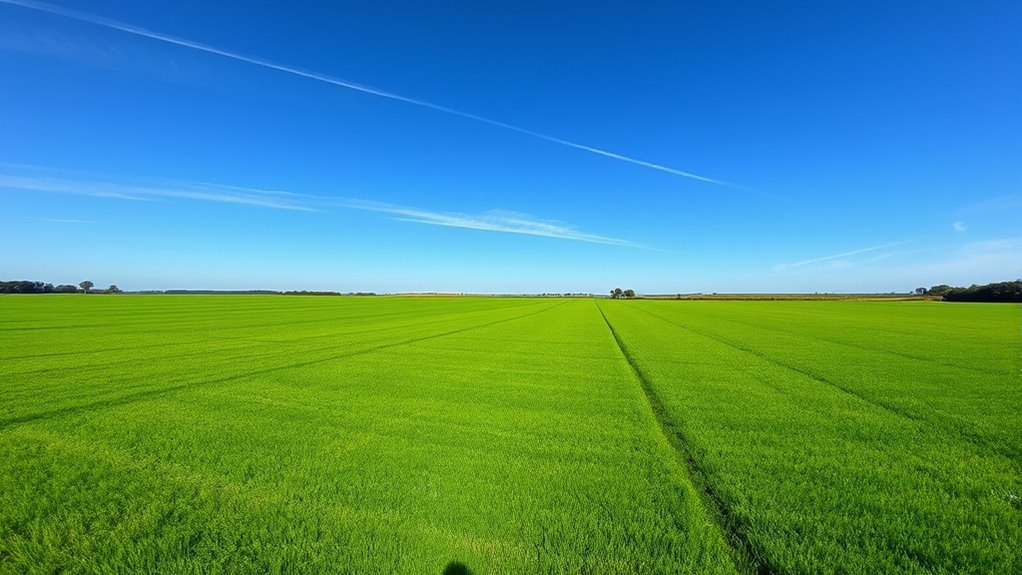
Many chemtrail theories rely on assumptions and selective observations rather than solid evidence. You won’t find credible proof linking these trails to harmful aerosols affecting health. Most claims are fueled by conspiracy funding rather than scientific research. To understand why these theories fall apart, consider:
Chemtrail claims lack credible evidence and are driven by assumptions rather than scientific proof.
- Lack of consistent, verifiable sample data on aerosol health impacts
- No credible scientific studies confirming large-scale aerosol spraying
- Misinterpretation of normal aircraft contrails as chemtrails
- The absence of government or agency documents supporting conspiracy claims
These points show how easily misinformation spreads when evidence is ignored. Without tangible proof, most chemtrail theories remain unfounded, relying on speculation instead of facts. The scientific community continues to dismiss these claims as baseless.
The Impact of Misinformation on Farmers and Rural Communities
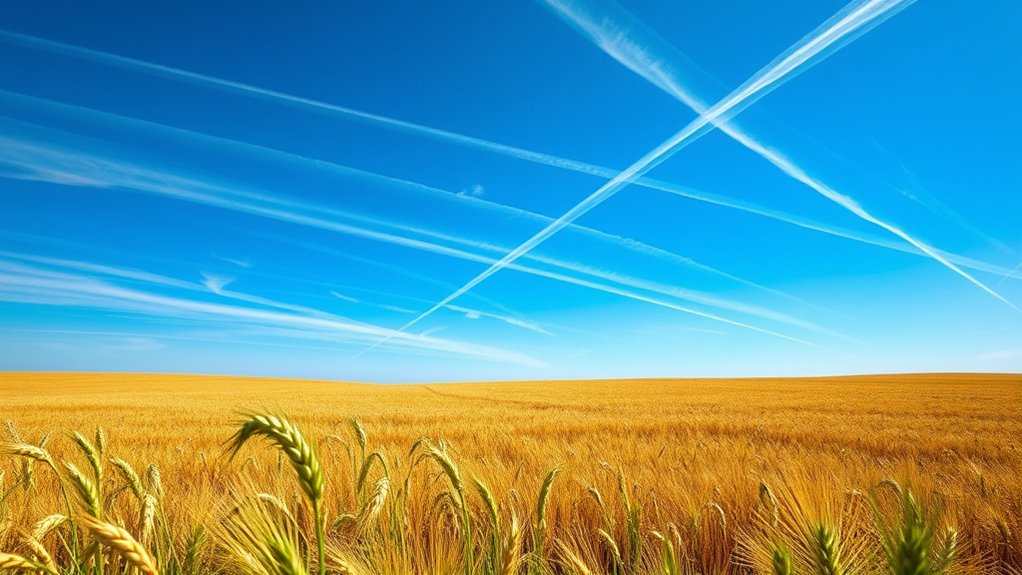
Misinformation surrounding chemtrail theories doesn’t just stay online; it can have real consequences for farmers and rural communities. False claims about aerosol sprays can lead to unwarranted fears about agricultural pollution, causing farmers to doubt their methods and avoid certain practices. This misinformation can also hinder rural education, as residents may become skeptical of scientific explanations about weather, climate, or crop health. When communities buy into these myths, they might resist credible advice from experts, risking crop yields and environmental health. The spread of false information damages trust and creates confusion, making it harder for farmers to implement effective, science-based solutions. Additionally, Crochet Styles for Locs can serve as a creative outlet that promotes mental well-being amidst such misinformation. Addressing these myths is essential to protect rural livelihoods and promote accurate understanding of environmental issues.
Observing the Sky: How to Distinguish Between Real and Alleged Chemtrails

When observing the sky, distinguishing between genuine contrails and alleged chemtrails requires careful attention to their appearance and behavior. Chemtrails often appear as persistent, spreading clouds that linger for hours, unlike typical contrails that dissipate quickly. To tell the difference, look for signs like:
Genuine contrails dissipate quickly, while chemtrails linger and spread across the sky.
- Contrails that form and fade within minutes
- Trails that expand and cover large areas over time
- Unusual patterns or grid-like formations
- Consistent altitude, unrelated to weather changes
Aerial surveillance equipment used in pollution monitoring can reveal ongoing atmospheric activities, helping identify real contrails from suspicious trails. Chemtrails, if they existed, would likely be part of clandestine operations, not regular flight paths. Paying close attention helps you avoid misinformation and understand genuine atmospheric phenomena.
The Importance of Critical Thinking When Evaluating Sky Phenomena
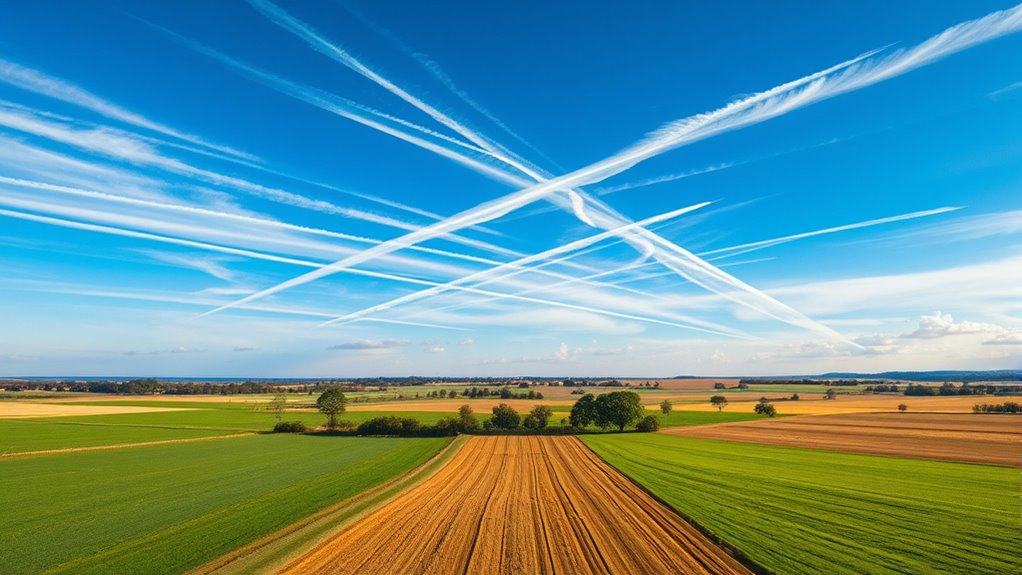
Because sky phenomena can easily be misinterpreted, applying critical thinking is essential when evaluating what you see overhead. Start by examining satellite imagery from reputable sources to verify if unusual patterns are documented or linked to natural or human-made activities. Comparing current observations with historical documentation can help you recognize common sky phenomena, like contrails or atmospheric conditions, versus unusual or suspicious activity. Be skeptical of claims without supporting evidence, and consider alternative explanations rooted in science. Remember, many misconceptions stem from misinterpreting images or outdated data. By questioning initial impressions and seeking credible information, you’ll develop a clearer understanding of what’s happening in the sky and avoid falling for myths or misinformation. Critical thinking empowers you to see beyond surface appearances and evaluate phenomena accurately.
Frequently Asked Questions
How Do Chemtrail Conspiracy Theories Affect Local Environmental Policies?
You might not realize it, but chemtrail conspiracy theories can influence local environmental policies by fueling concerns about aerial spraying. When community members believe in these theories, they often push for stricter regulations or bans on aerial activities, which can impact policy decisions. This policy influence can divert attention from real environmental issues, making it harder to address genuine concerns like pollution or climate change effectively.
Are There Any Documented Health Risks Linked to Chemtrail Exposure?
You might wonder if chemtrail exposure causes health risks. Scientific studies show no credible evidence linking chemtrails to chemical exposure or respiratory issues. While some believe chemicals released in chemtrails could harm health, experts haven’t found any documented health risks. It’s important to rely on credible research, as unverified claims can lead to unnecessary fear. Currently, there’s no scientific proof that chemtrail exposure results in health problems.
What Role Do Government Agencies Play in Dispelling Chemtrail Myths?
Imagine clear skies where the truth shines through, revealing the role of government agencies. They actively promote transparency and public education to dispel chemtrail myths. By sharing factual data and engaging communities, they help you see beyond the misconceptions. Their efforts aim to replace confusion with understanding, guiding you toward a clearer view of airborne realities. Through this, they empower you to distinguish fact from fiction in the sky’s story.
How Can Educators Better Address Misinformation About Atmospheric Phenomena?
You can better address misinformation about atmospheric phenomena by enhancing your students’ visual literacy and scientific communication skills. Use clear visuals, diagrams, and videos to explain complex concepts, making science accessible and engaging. Encourage critical thinking by analyzing sources and questioning claims. By fostering these skills, you’ll help students distinguish facts from myths, empowering them to confidently navigate and debunk misinformation in the digital age.
What Psychological Factors Make People Believe in Chemtrail Conspiracies?
You might believe in chemtrail conspiracies because cognitive biases, like confirmation bias, lead you to favor information supporting your fears. Social influences, such as peer pressure or media, can also shape your beliefs by reinforcing distrust in authorities. These factors make it easier for you to accept conspiracy theories, especially when they provide simple explanations for complex issues. Recognizing these influences helps you critically evaluate such claims more effectively.
Conclusion
As you observe the sky, remember that not every trail is what it seems. The truth behind chemtrails is clearer than many believe, but questions still linger. Will you accept simple explanations, or will you dig deeper and uncover what’s truly happening above your fields? Stay curious, question boldly, and never stop seeking the facts—because sometimes, the most surprising truths are hidden right in plain sight. The sky’s secrets might be closer than you think.
